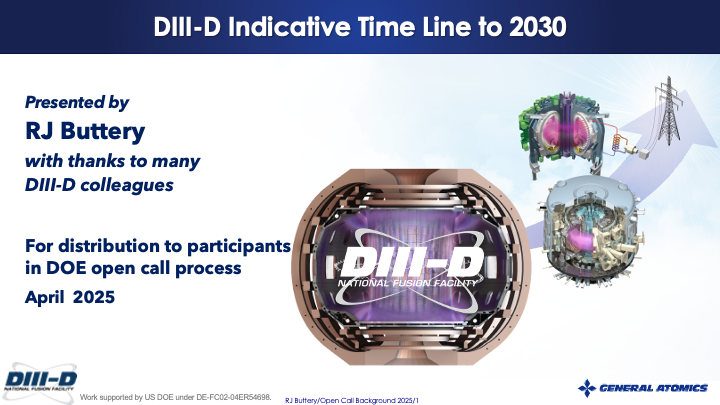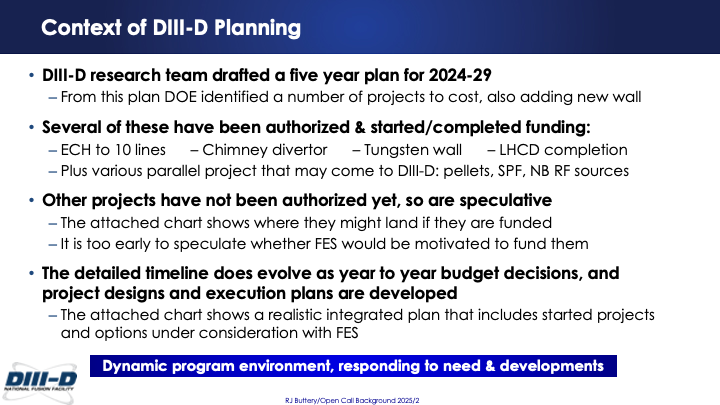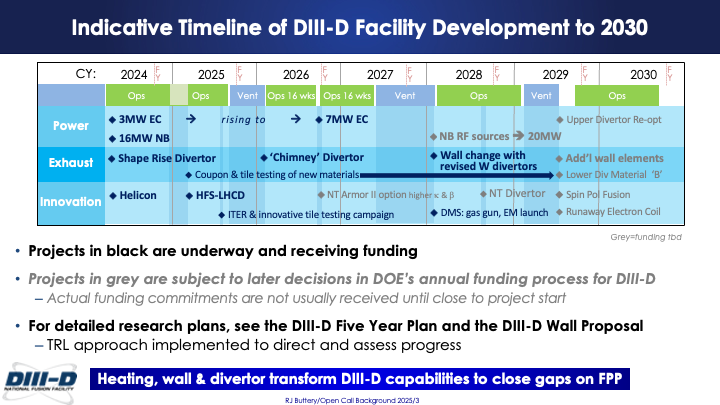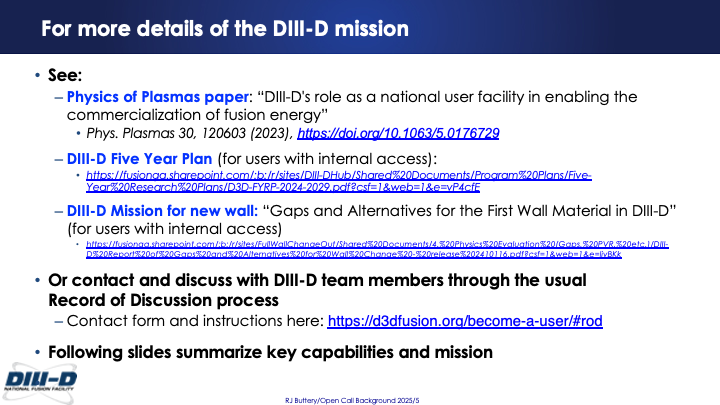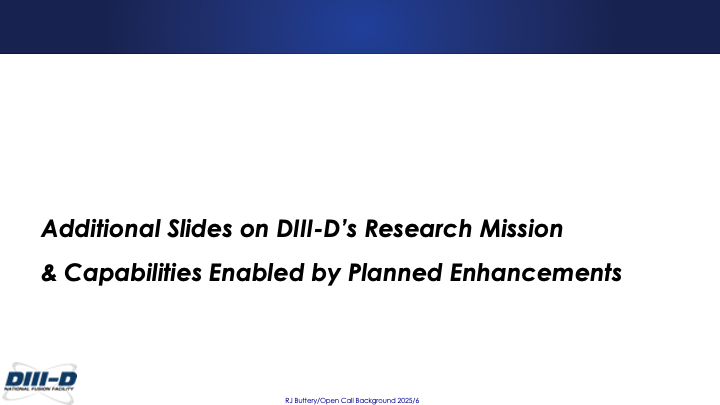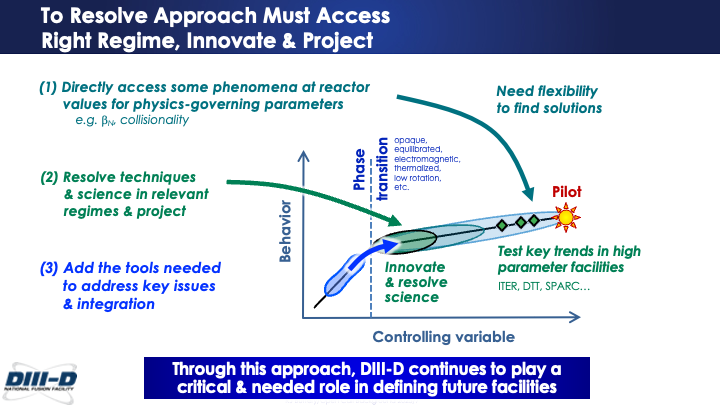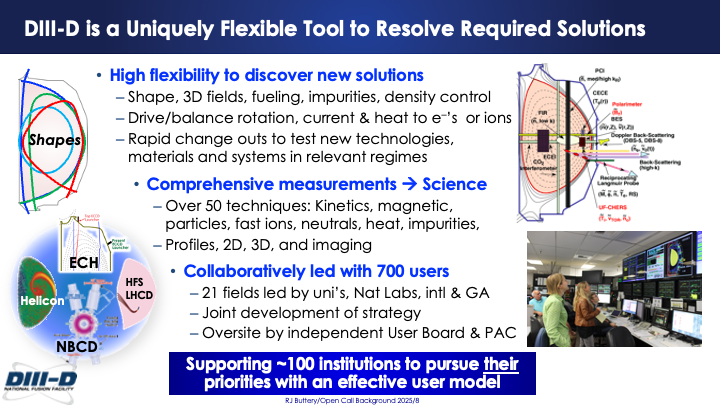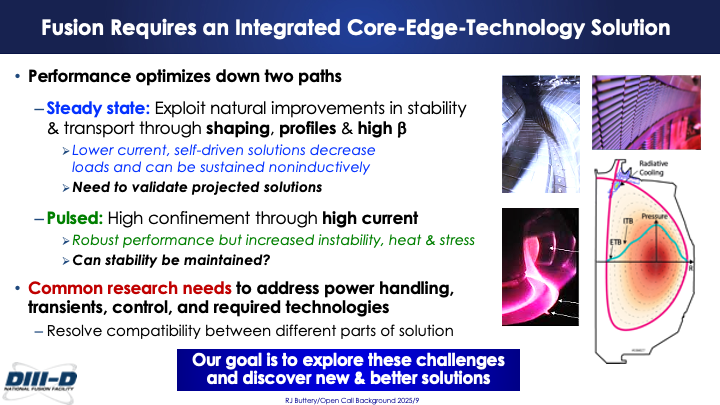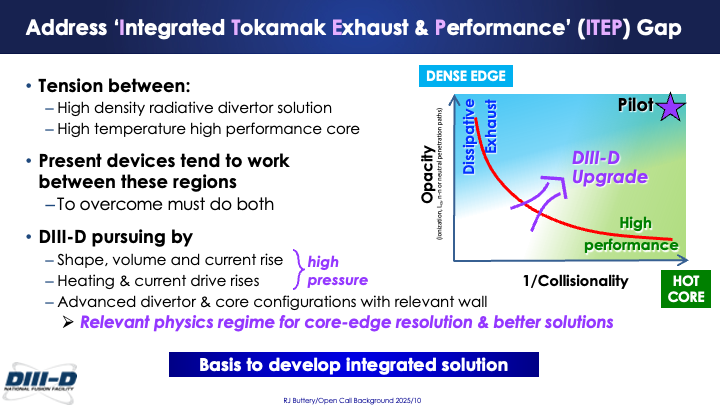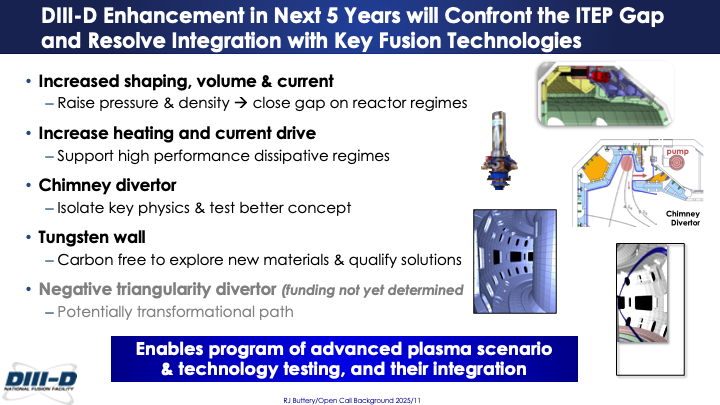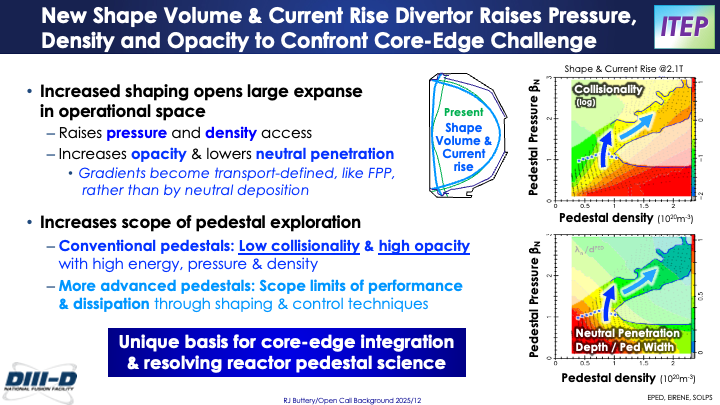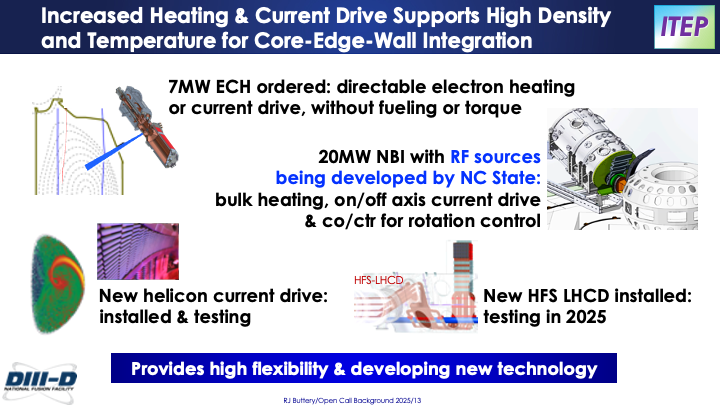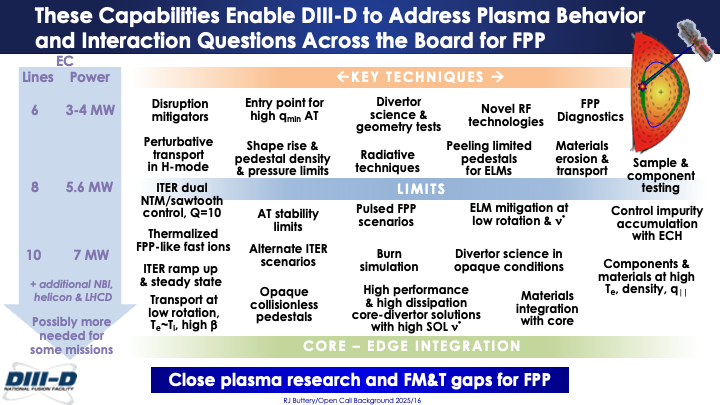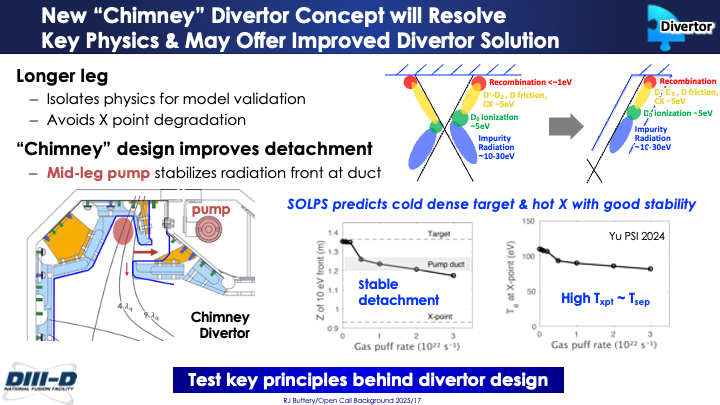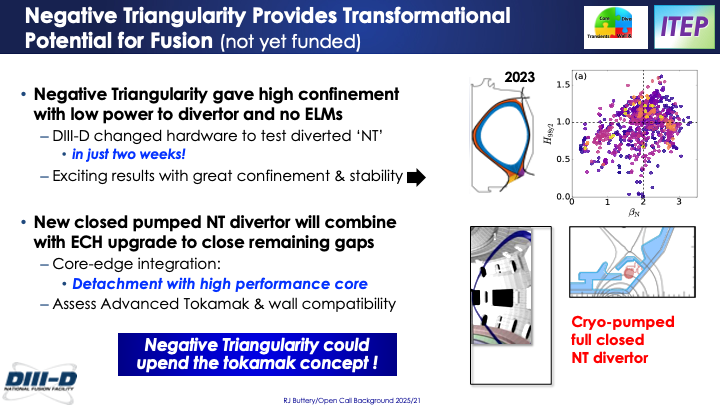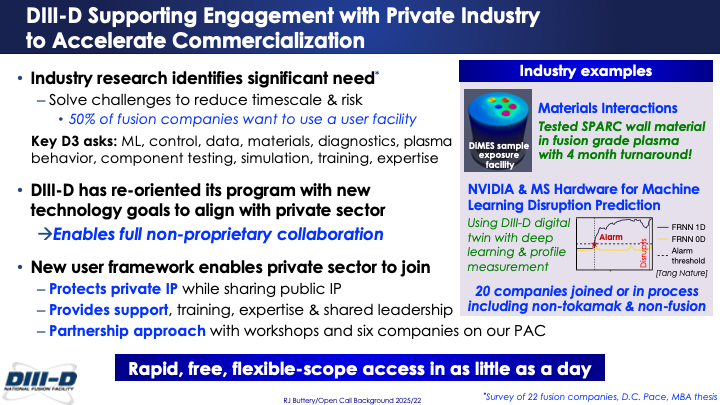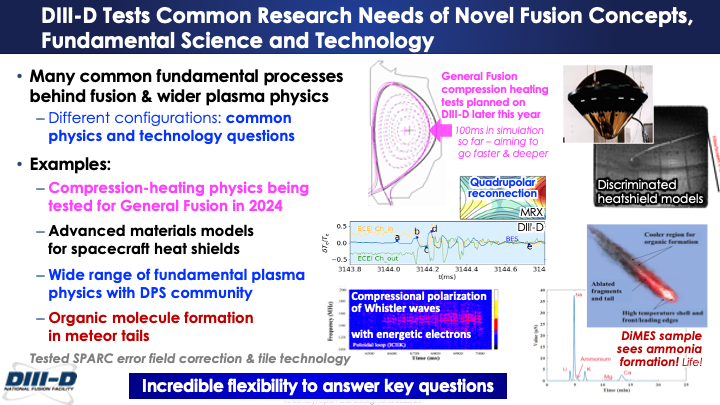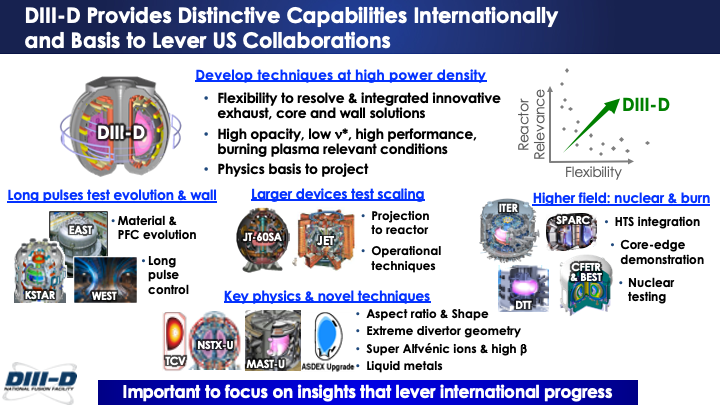DIII-D Specific Information Related to 2025 Funding Opportunities
in U.S. Department of Energy, Fusion Energy Sciences Program Areas
Background
The U.S. Department of Energy (DOE), Office of Science, Fusion Energy Sciences (FES) program provides information on funding opportunities from their webpage.
The information provided below relates to specific information concerning how the DIII-D National Fusion Facility is one possible destination for proposed work under current funding opportunities. Please see the requirements defined by DOE in the two PDF downloads here:
Applications from Universities and Other Research Institutions to the Annual Open Solicitation
FY 2025 Continuation of Solicitation for the Office of Science Financial Assistance Program
The DIII-D information below is provided to assist applicants in the creation of their proposals. Should there be any conflict in information with DOE sources, then the DOE source information supersedes the DIII-D information provided below.
Summary Downloads and References
The following documents provide additional technical detail concerning DIII-D mission:
- DIII-D Five-year Research Plan 2025 – 2029 🔒 (internal document available to users)
- Gaps and Alternatives for the First Wall Material in DIII-D 🔒 (internal document available to users)
- DIII-D’s role as a national user facility in enabling the commercialization of fusion energy, R.J. Buttery, et al., Physics of Plasmas 30, 120603 (2023)
The information provided below has been summarized in the following two downloads:
Record of Discussion
Applicants submitting proposals that involve research activities at DIII-D need to complete a Record of Discussion (ROD). Not all proposals require that the ROD be submitted with the application, but the DIII-D program must have its ROD for coordination with the FES program within US DOE Office of Science.
The purpose of the ROD is to help applicants prepare a proposal that is consistent with the capabilities and plans of the DIII-D Program and to provide advance notice to FES concerning the potential resources required to support this proposed research. The ROD is not a merit review.
Please see the following information for full instructions on how to complete a Record of Discussion.
Timeline of DIII-D Capabilities

- Projects in black are underway and receiving funding
- Projects in grey are subject to later decisions in DOE’s annual funding process for DIII-D
- Actual funding commitments are not usually received until close to project start
- For detailed research plans, see the DIII-D Five Year Plan and the DIII-D Wall Proposal
- TRL approach implemented to direct and assess progress
See the presentation slides below for a full overview of capabilities and research plans. This is the same content that is linked above as Timeline of DIII-D Capabilities.
Essential Service Roles
This information addresses the question of how to flag “Essential Service Roles” at DIII-D National Fusion Facility as part of research proposals to the open call. The open call for tokamak research from DOE invites institutions to propose scientist and other resources for various roles and research associated with the DIII-D program. One aspect of engagement at DIII-D is the provision of systems and support by users, to other users. While some of this provision is to support the specific topical research goals of an award recipient or their collaborators, some aspects represent general contributions that are essential to facility operation or basic data provision – these are what we deem “essential service roles”.
Discussion with the DIII-D User Board, and further consultation with FES, has identified a set of such service roles provided under research funding that the program will seek to ensure are supported as far as is reasonably possible. These are activities that are either essential for operation of the facility, or they provide foundational data to most scientists that exploit the facility, such as basic equilibrium reconstruction, main parameters or key profiles. The identification of such roles is based on activities that or involve capabilities difficult to replace (skills or systems) in this category, and/or require substantial training (more than one year).
For reference, DOE’s guidance on this matter is “In some cases, users at DIII-D undertake activities that provide general support to the program that is essential to operation or basic data provision, rather than the needs of a single grant. If your institution undertakes such work, please detail its nature, FTE count and cost in an appendix of the proposal, and also include it in the main proposal scope and costs. Efforts that target enhanced capability or provision for a specialist narrow set of research fields, rather than general user support, should be addressed in the main proposal. See the DIII-D Facility Director for a current list of qualifying service roles.”
The list of such roles is provided below. User institutions that wish to secure funding to provide such roles should (i) flag and budget the roles in their research proposal main section, (ii) note the activities as service roles in the appendix section of their proposal, including required FTE effort, cost and additional spends, and (iii) inform the DIII-D management of such so they can work out how to coordinate resources around these roles. It should be noted that inclusion of essential service roles in a proposal does not guarantee acceptance of that research proposal.
Here is the list of qualifying essential service roles for DIII-D, with description of scope:
1. Research Management
This category covers essential tasks involved in the overall coordination of research division to execute and organize a program involving hundreds of proposals and dozens of experiments each year, overseeing preparation and analysis of those experiments, and the development of research products. This also includes coordination of a wide array of support activities, research planning, and analysis and advice on a wide range of facility development activities. These aspects are undertaken by:
- The Research Director and Deputy, and the 6 Group Co-Leaders that coordinate the program in 3 main sections, each comprising several topical research areas. These 8 people each spend 50-70% of their time to manage activities to deliver the research program.
-
- FES has flagged that Group Co-Leaders may evolve under the new organizational structure. The form of this evolution is not determined yet, and will, we suspect, depend on the proposals to and outcomes of the open call.
- The run coordination team, who schedule experiments and resources, and identify needs and challenges to ensure each experiment selected is executed with best possible support. This is a team of 5-6 people (with roll-off and trainees) at 20% time and chief run coordinator at 55%.
2. Physics Operation
Physics operation provides deeply trained and experienced personnel who are intimately familiar with DIII-D systems and control architecture. The physics operation team comprises:
- 12-14 scientists who each provide around 10-30% of their time for Physics Operation (variable according to expertise – some much more deeply engaged). Training takes a minimum of 1 year but full expert level needs 2-3 years. This includes second physics operators, who are often on a training path to primary physics operators, support some session in the primary role and/or provide physics operation of specialist systems.
- Additional scientific effort is needed to coordinate physics operations of DIII-D, including providing overall coordination, the role of Chief Physics Operator, startup and facility commissioning, and some minor support activities – presently this uses 2-3 people with ~1.7 FTE.
3. PCS Scientific Support, EFIT and Control Algorithm Development
Provides scientific expertise in the development of essential control and reconstruction software, and provision of the plasma control system, including specialist scientist engagement:
- PCS provision itself (a PCS science lead works with operations PCS lead and experts)
- Post-shot EFIT code management and reconstruction support
- Real time EFIT maintenance
- Control algorithm development and testing by expert control scientists to support the needs of particular experiments requiring this expertise
Note: This work is not control research to develop new techniques, but rather the work required to implement particular controls to help users realize particularly complex requirement in particular experiments. It is highly expert in nature, requiring an intimate understanding of DIII-D hardware and software systems.
4. Primary Diagnostic
These activities provide support for systems needed by most experiments, and/or needed for machine protection, control or operation. This includes provision of basic plasma parameters and reconstructions needed as a basis for all analysis. It also includes activities to provide basic working systems with provision of measurement hardware, interface to data acquisition, commissioning, calibration, provision of analyzed data, and associated code maintenance. The essential diagnostics needed in this category are:
- Magnetics (equilibrium, diamagnetic loop and MHD diagnostics)
- Interferometer
- Charge exchange
- MSE
- Thomson scattering
- Bolometry
- SPRED
- Langmuir probes
- Electron Cyclotron Emission
- IRTV
- Filterscopes
Service effort to the wider program for these roles should be clearly delineated from research into the physics of these techniques or specialist research conducted with them.
5. Essential Hardware Support by Scientists
In some cases, particular hardware is supported by scientists, where specialist scientific input remains key to ensure the system is well running, addresses problems encountered, and system developments avoid pitfalls and are well developed. Key areas include:
- Neutral beam heating scientist (small fraction FTE)
- Electron cyclotron heating and current drive scientist (small fractional FTE)
- Pellet systems, which are widely used tools across many studies (extensive effort by ORNL scientists to provide this system)
- Impurity power dropper
Service effort to the wider program for these roles should be clearly delineated from research into the physics of these techniques or specialist research conducted with them.
6. Essential Code Support
This includes a few codes that are essential to running the machine or provision of general information needed for most studies, such as reconstruction of basic properties.
These tools are:
- OMFIT
- Pedestal tools
- GA profiles
- ONETWO
- reviewplus
- Calibration codes for primary diagnostics
(Note: EFIT is placed in the PCS section to align RT EFIT and post-shot EFIT in one place)
This excludes specialist analysis codes that pertain to narrow physics fields, as scientists operating in those field will typically bring such codes as part of their scientific work.
Excluded from this list (i.e., to be part of topical research under NOFOs) are:
- PI work specific to research funding awards
- Research activity – experiments, analysis, paper writing, proposals, support to colleagues in specialist areas with specialist tools (see above)
- Specialist diagnostics and code support that serves a particular field or two, not the general program
- Scientific opportunity and leadership roles such as topical area leader, thrust or task force leader, invited talk presentations, project leaderships that are pertinent to specialist area funded
- Support roles that are small time fractions and easily trained where personnel can be canvassed from the program (Examples: diagnostic coordinators)
- Institutionally oriented management and staff supervision tasks within institutions
User Board Engagement
The DIII-D Research Program supports a User Board that is an independent organization chartered by FES to represent and coordinate activities of the DIII-D research team. The User Board provides the following mechanisms for existing and potential DIII-D users to coordinate preparation of proposals in response to the current opportunities.
The current call for proposals for Tokamak Research includes applications for Research Coordination and Program Coordination Roles. In order to facilitate the coordination of submissions in these new categories we provide a tool to collect and share expressions of interest (EOIs).
The submission is entirely voluntary and responders are welcome to check which boxes they wish to express interest in.
- Google form to express interest in Cat. 1 and 2 proposals: Research Teaming EOI Form
- Spreadsheet to view other responses: Research Teaming EOI Responses
- Google form to express interest in Cat. 3 and 4 proposals: Coordination EOI Form
- Spreadsheet to view other responses: Coordination EOI Form Responses
We hope these forms will be is a valuable contribution to your efforts at team formation. The UB Chairs will not be actively moderating the content nor actively promoting any teams. This is a passive forum for us all to use.
Please note: All forms are open for anyone to use. All responses are publicly viewable.

